
Four early publications on the Second Congress held in Basel in 1898. Some published a few days before it took place, and some immediately after it.
* Reden gehalten auf dem II Zionisten Congresse zu Bazel [speeches of Herzl Nordau and others in the Second Zionist Congress]. Vienna, 1898. Booklet in which the speeches of Herzl, Max Nordau, Dr. Max Mandelstam and Rabbi Moshe Gaster were printed. As part of the decisions of the Congress, the decision was made to print and distribute this booklet. (Gaster's speech was quoted "because of the strong impression he made on the listeners in its rhetorical beauty"). On the back of the booklet "Verlag des Vereines "Erez Israel": [Published by the Eretz Israel Association]. German.
* Ideas for the Second Zionist Congress by Dr. Mordechai Ehrenfries, Ahiasaf Publishing. Berlin, 1898. The pamphlet was published a few days before the congress, in which Dr. Ehrenfreiz laid out his views on the purpose of this congress ('The second congress should be a congress of internal work ... at the second assembly we are waiting for real work in all branches of the movement').
* Stenographic protocol (complete) from the negotiations at the Second Zionist Congress in the city of Basel 10-22 Elul 1898. Warsaw 1899. protocol of all the speeches of the various speakers in the Congress, with Herzl at their center, with a chronological division according to the days in which the Congress took place.
* Knesset Hagdolah or the Second Congress in Basel. Details of all proceedings of the Second Congress in Basel, meetings, negotiations, speeches and resolutions. Edited by Nahum Slushtz. Warsaw 1898 . Extensive overview of the great moments in the Congress.
General condition: good - very good.
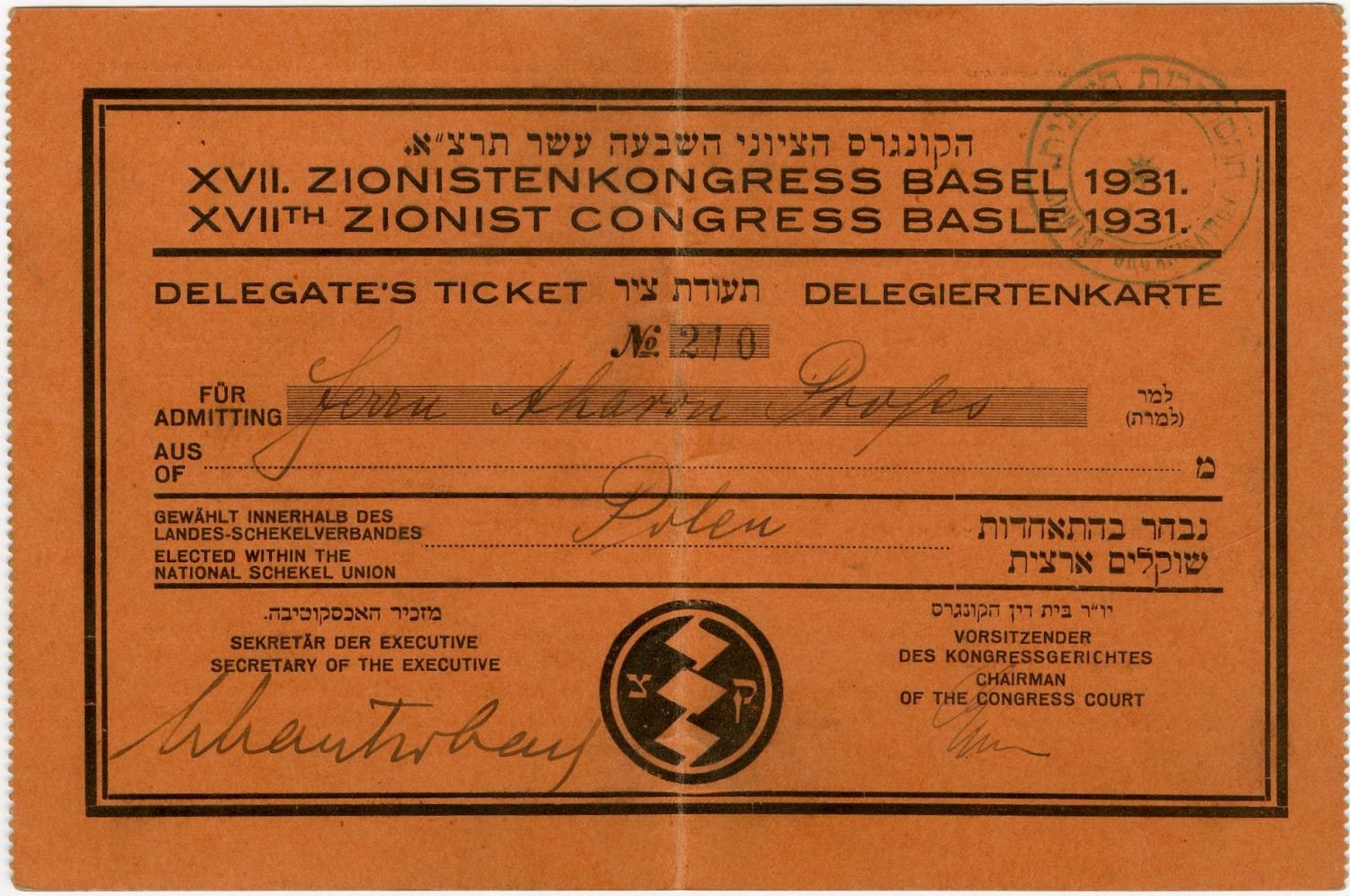
Axis Certificate' of the participant Avraham Proper (No. 210) at the 17th Zionist Congress held in Basel in 1931. Rare.
On the back of the card are instructions in Hebrew, German, and English, which state that the card entitles the holder or his proxy to attend all congressional meetings, and that he must present the card upon entering and leaving the hall, even if he is not asked to do so.
This congress is especially remembered in the history of the Zionist congresses because the revisionists' proposal to declare the aspiration to establish a Hebrew state on both sides of the Jordan was rejected, after the deputies of "General Zionists B" and the "Mizrachi" changed their position in favor of the proposal, following a telegram received from the Haganah headquarters, that such a decision could lead to the resumption of riots in the Land of Israel. In response, Jabotinsky rose from his chair and Shout: "This is not a Zionist Congress!". He tore his axis card and left the hall, followed by all his party axes as well.
Size: 18x12 cm. Folding mark in the middle. Good condition.

An elegant booklet in large format, published in honor of the 21st Zionist Congress - Geneva 1939 on behalf of the Zionist Organization, and distributed to delegates and guests who participated in it. The booklet contains many photographs of the Zionist enterprise - some of them photomontage photographs, and articles examining the progress of the enterprise from Congress to Congress. On page 2 is a symbol specially designed for this Congress. Hebrew, English, French, German.
The pamphlet, As usual in pamphlets distribute in such events, is in fact a sort of summary of the Zionist Congresses and their results up to this Congress, and it reviews the developing Jewish settlement enterprise in Israel in all its branches, and the Zionist Congresses from the first; the rise and fall of the number of Shekel donors from Congress to Congress. Industrial plants in Eretz Israel, reports of income and expenses, etc. Its purpose was: "To highlight and illuminate the summit points of the entire construction work. And these summit points were chosen in such a way that they can present a clear crossword puzzle picture from the entire work of the Creation... " (from the introductory). The cover of the booklet in a special design: Herzl's Israeli flags (with the seven stars) against the background of the Jewish Agency building. Many advertisements of Israeli manufacturing companies.
[106] p. Large format: 33 cm. Thick and fine paper. Slight tear in corner of cover. good condition.
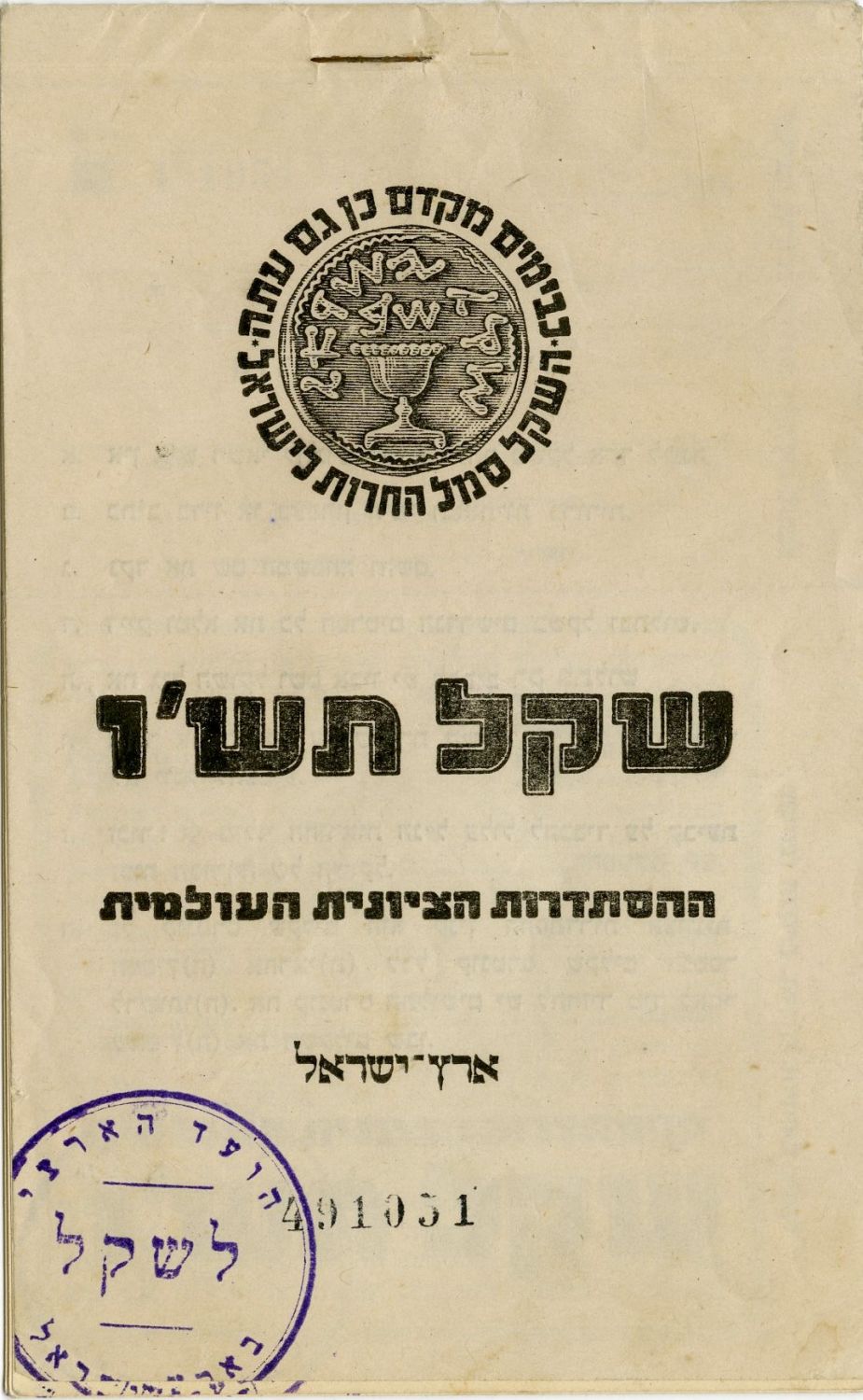
A receipt book holding 8 receipts (Out of 10, numbered from 491051 to 491060) for the donation of the Zionist shekel, all signed with an ink stamp of the 'National Committee'. Eretz Israel 1946. Rare.
On the first and last page 'Instructions for Distributors' in Hebrew: 'No one is allowed to purchase more than one shekel per year', etc. On the last page of the booklet, a number of lines were printed concerning the fateful hour linking the shekel donation to the mass commander: "Distributor! The time for a decision has come! A weighty value in the decision for the mass commander by the shekel. So, immediately distribute all the shekels handed over to you and remove the consideration without delay, do not miss the hour!"
17x11 cm. Excellent condition!

The HaTikva Tripoli School under the direction of the "Ben Yehuda" Enlightenment Department of the Zionist Organization in Tripolitania - a souvenir for the day of the awards ceremony for the fourth year, the week of Sukkot 1935. Honorary Director: Mazal Tov Ben Gur Aryeh Kastilbulonizi Shlit"a.
An interesting and one-time booklet published by students of the "Hatikva" school in Tripoli and includes the principles of the Zionist organization 'Ben Yehuda', along with short articles about 'our leader' Theodor Herzl and Eliezer Ben Yehuda. There are also photographs from the celebration of the awarding of prizes at the school, the names of the winning students, and an interesting detail about the school's activities in Hebrew, and in Arabic in Hebrew letters.
The 'Ben Yehuda' organization was founded in Libya in 1931 and immediately began extensive Zionist activity: introducing the Hebrew language, according to the slogan "Hebrew speaks Hebrew"; staging plays in Hebrew on biblical and national issues; organizing sports games; holding ceremonies and parties at every religious and national holiday; Collection of the shekel for the Zionist Organization and the Jewish National Fund. The highlight of Ben-Yehuda's activities was the establishment of the 'Hatikva' Hebrew school for the children of Israel for free (Cheshvan, in late 1931). The framework of study included the division of classes according to level, conducting achievement exams; learning Jewish and Zionist subjects; general studies; physical education and learning the laws of etiquette and Derech Eretz. Biblical and national plays in Hebrew; Learning Hebrew poetry and founding a choir; Holding parties and celebrations at the end of the school year and traditional and national Israeli holidays; Organizing processions; Collecting funds (mainly for the Jewish National Fund) and showing films about what is happening in Eretz Israel. The number of students in the school jumped from only 20 students at its opening to 512 boys and girls at the end of 1932, when in 1938 their number reached 1,200 boys and girls students.
A rare publication that does not appear in the National Library.
16 p. 24 cm. Soft cover. Stains on cover, good condition.
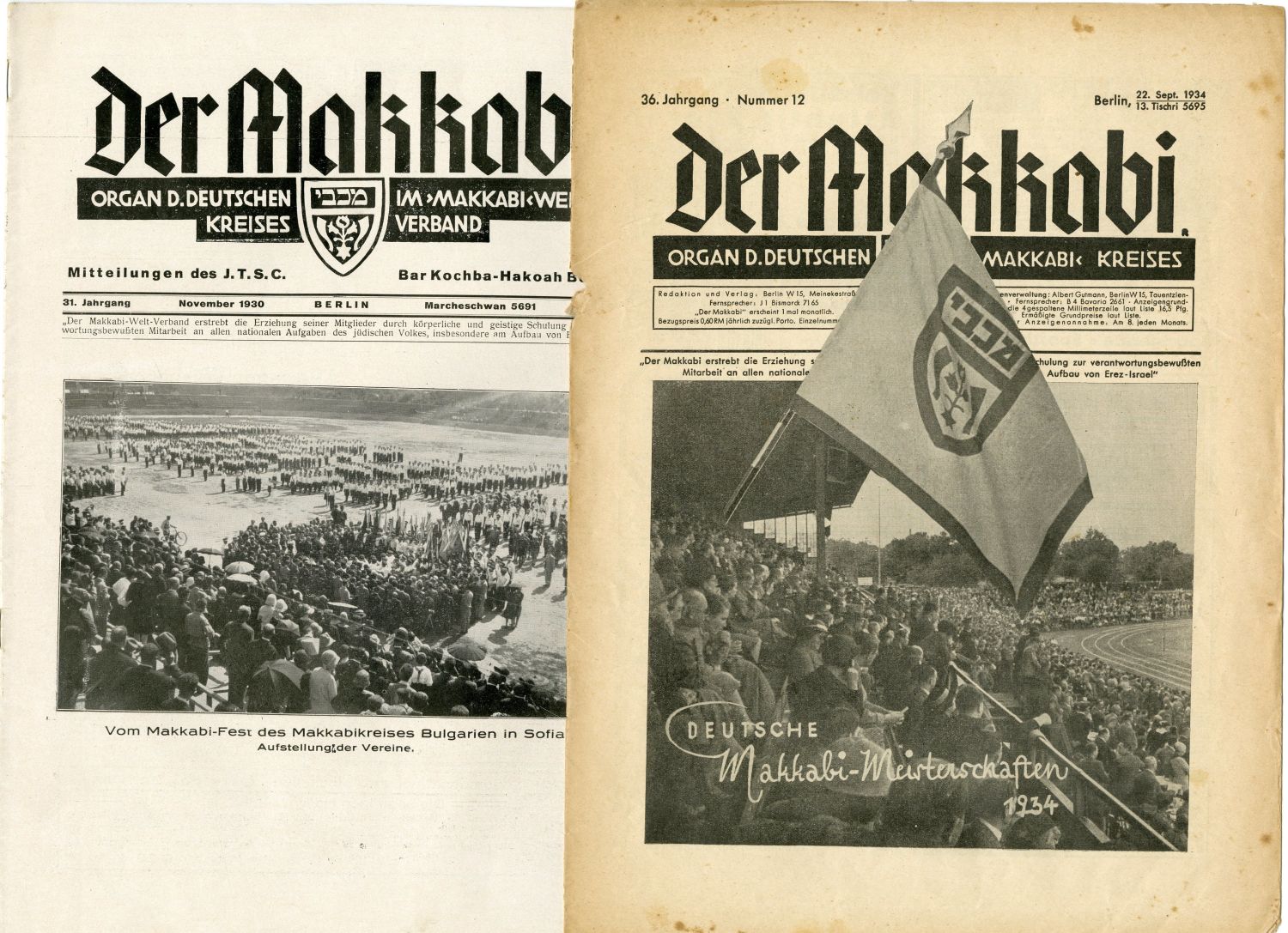
Der Makkabi - Issues No. 11 and 12 (different years) of the German-Jewish Sports Club magazine from the capital, Berlin. November 1930, September 1934. On the title page of the two issues is the historic Maccabi Berlin logo, one as part of a flag, and the other under the title of the issue.
The 1934 issue actually sums up the championship that year, and in the opening, there is an interesting reference to Nazi Germany: "It was a sports demonstration that German Jews have never seen ... 'Maccabi' proved once again that it is the leading Jewish sports association in Germany ... even German sportsmen present expressed, Even our great haters did not remain indifferent ... The German daily newspapers first covered the Jewish sporting event!".
The Maccabi Berlin Sports Association was established in 1898 under the name "Bar Kochba Berlin". In 1930 it was one of the largest Jewish sports organizations in the world with 40,000 members from 24 countries. The association also included a football department that competed in the Berlin city leagues from 1911–1929. In 1929, the Bar Kochba movement merged with the Berlin Power Movement to found the "Bar Kochba HaCoah" movement. The Berlin HaCoah Team was a relatively successful team when it managed to compete in the lower leagues of the German Championship and was considered a fairly successful professional football club from 1925–1927. In Other sports were particularly prominent, the athlete Martha Jacob, who won the title of German Champion (1929), fifth in the world and runner-up Maccabiah II (1935) in javelin throwing, and Alex Natan, who won the title of German Champion for several years (1926, 1927, 1929 and 1930) and partner in a world record in the 4x100 meter relay.
In the 1930s, with the rise of the Nazi Party, Jewish football teams were rejected by the sports associations from participating in general competitions and were restricted to tournaments and restricted leagues. With the strengthening of Nazi Germany, the end of the Jewish groups came in 1938. Some of the members of Bar Kochba immigrated to Eretz Israel in 1933 and settled in Rehovot, where they joined Maccabi Rehovot.
Two complete sheets, very good condition.
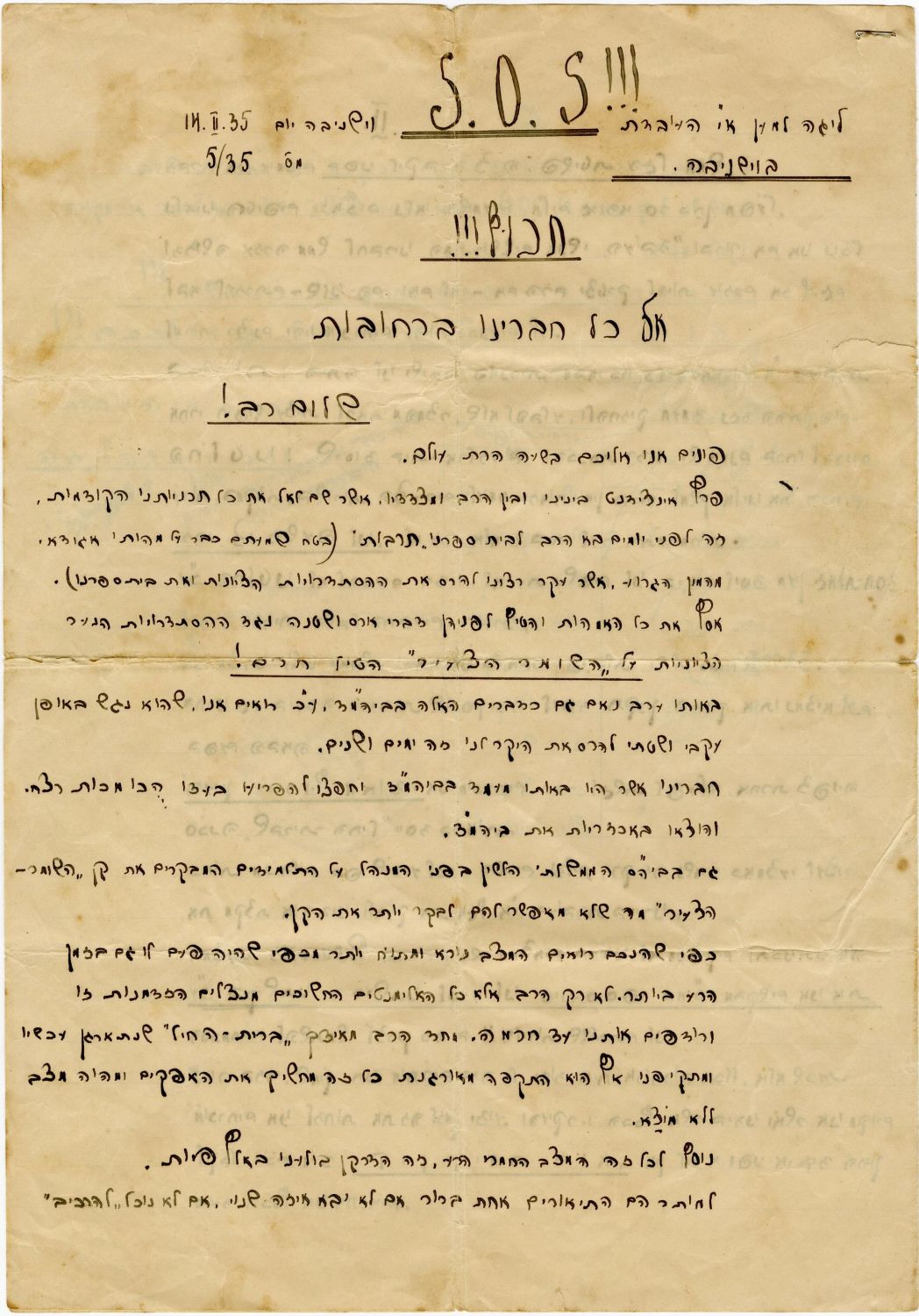
S.O.S. - "Urgent !!! To all our friends in Rechovot", a handwritten letter from the "League for the Working Land of Israel" in Wiszniewo requesting urgent assistance while the youth stopped performing in the nest. Wiszniewo, Poland [then], 1935.
"We turn to you at an A fateful hour". In their letter, the league members state that the rabbi of the town came to the Tarbut school: "Gathered all the mothers and preached before them words of venom and hatred against the Zionist youth unions, on the 'Hashomer Hatzair' imposed a boycott." and how he caused the youth to stop coming and perform at Ken Hashomer Hatzair. "As you can see, the situation is more terrible and tense than it once was, even in the worst of times".In response to the depletion of the movement, the members propose to stop organizing dance parties, and to move to the social activity of charitable giving and mutual help, and ask their friends in Rechovot to help them financially.
The letter is signed by the group's leaders, including Zvi Meltzer (Shimon Peres' grandfather, who perished in the Holocaust in 1942), Dov Levin, Zeev Shuv, and Moshe Rabinowitz. As well as the ink stamps of the league, the Wiszniewo branch of the Histadrut "Hechalutz" and the "Hashomer Hatzair" branch in Wiszniewo.
[3] written pages, 30 cm. Folding marks. Stains. Good condition.
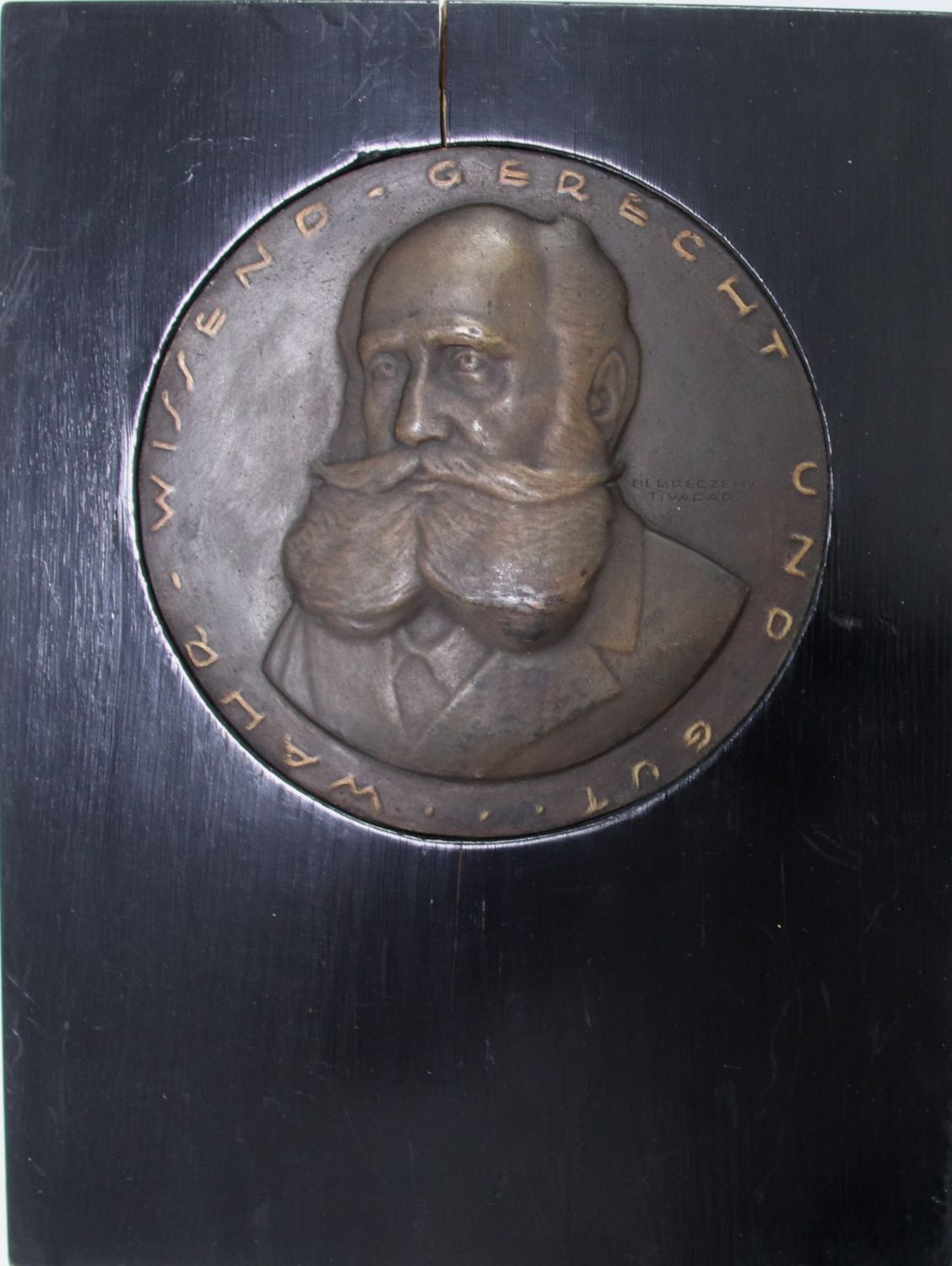
Portrait of Max Nordau [1849-1923] - Early bronze plaque - Signed: E. URECZENY TIVADAR Europe, Early 20th century.
All around are the words: WISEN GERECHT UND GUT in German: 'wisdom', 'justice' and 'good'. Quality and impressive work.
Nordau: One of the founders of the Zionist movement, the right-hand man of Theodor Herzl, the inventor of the "Muscle Judaism".
Size: 20x19 cm. Attached to a wooden board 35x27 cm. Fracture at the top of the wood. Very good condition.

"These are the words of the days of Dror Ben Yehuda" - a book designed and glorious on the occasion of the birth of the first daughter of Itamar Ben Av'i who died at the age of 4. New York, July 14, 1917.
On the pages of the book are graceful illustrations from the world of babies. The pages of the book were filled in sofer handsome handwriting. On the title page of the book: "These are the words of the days of Dror Ben Yehuda who was born to Leah and Ben Zion Ben Yehuda (Itamar Ben Avi) in the Greater New York exile in the first year of Dror Israel". Then there are passages explaining the meaning of the name given to her, her weight when she was born, names Bringing her first gifts, and a list of the gifts each brought, 'The first trip': 'On the ninth day of the birth ... We went with Dror to rest ... Her stomach was broken for the first time and we were forced to get used to the terrible pacifier ", as also appears under the heading 'The first curl' which a curl from the baby Dror's hair is attached. Below, interesting pages including 'her first shoes', her first Speak - when she was eight months old, her Speak and wisdom, etc. Attached her birth certificate, as well as Private cards in which Ben Avi invites to the celebration Her birthday.
Ben Avi married his wife Leah Abushdid after publishing a suicide song in his newspaper "Haor" under the name "My gun", threatening that if she did not marry him he would take his own life (after courtship of more than two years), her family surrendered, and the two married on the eve of Pesach. [1912] at the Amdurski Hotel. The eldest daughter of the two 'Dror' whose birthday was dedicated - the book before us - born in New York and died at the age of 4 (September 3, 1921), the middle daughter - was named after her sister who died and changed her name to 'Drora', and Rina, the youngest daughter.
[47] p. 30 cm. Spine partially detached (reinforced with glue). Good - very good condition.
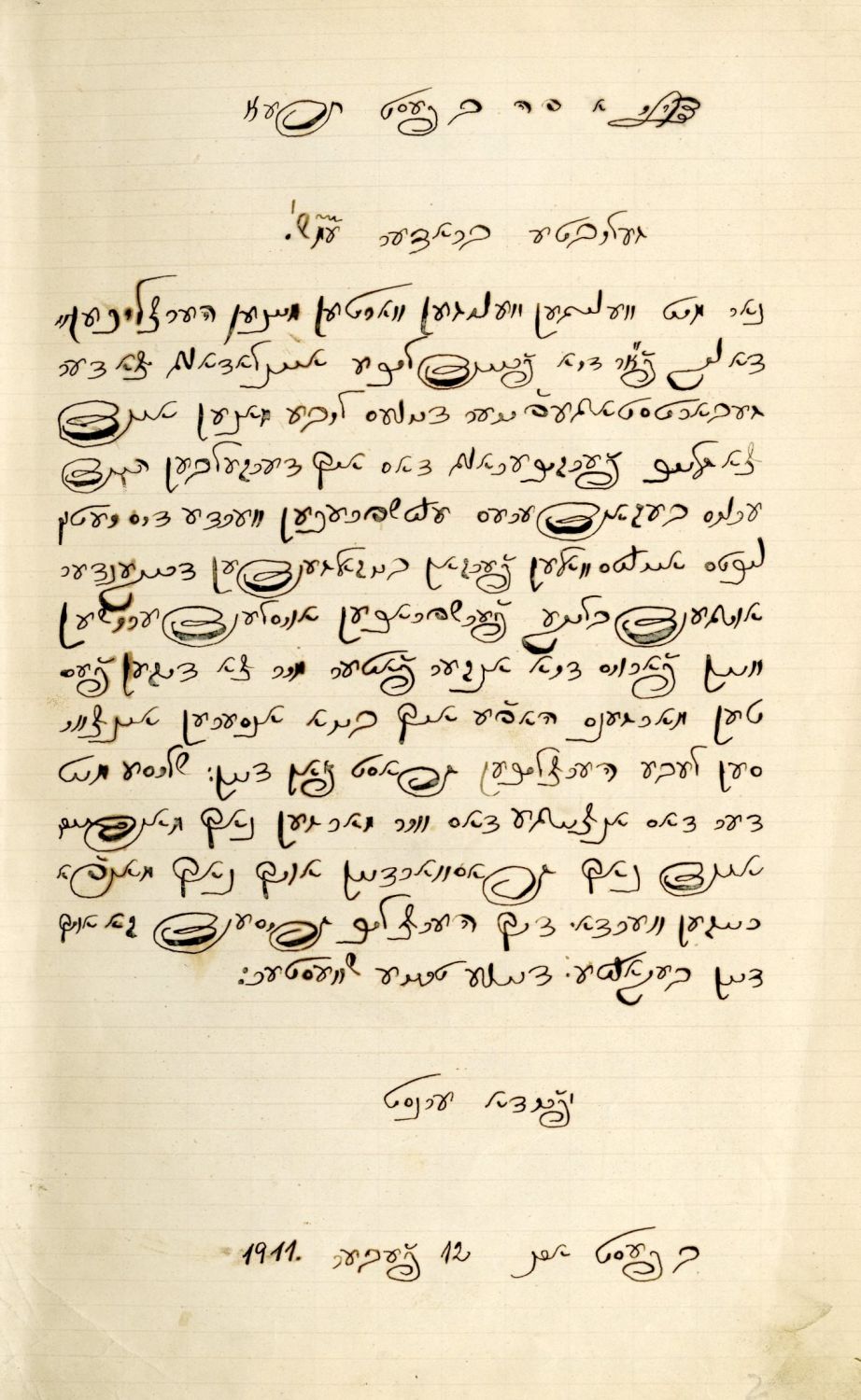
Letter notebook wrote in Budapest Frida Kuperstein between the years 1907-1911 - Happy New Year greetings to 'Rabbi and Rebbetzin', letters she sent to her father and mother, and more. From the letters one can learn much about the Jewish community in Budapest during these years, and about the status of the Jews in general. Some of the letters that appear were written by Kuperstein's friends Marska Kahn, Galia Kehar, Pinbatia Lektran, and by her family.
The notebook has not been thoroughly reviewed by us.
40 pages. Very good condition.
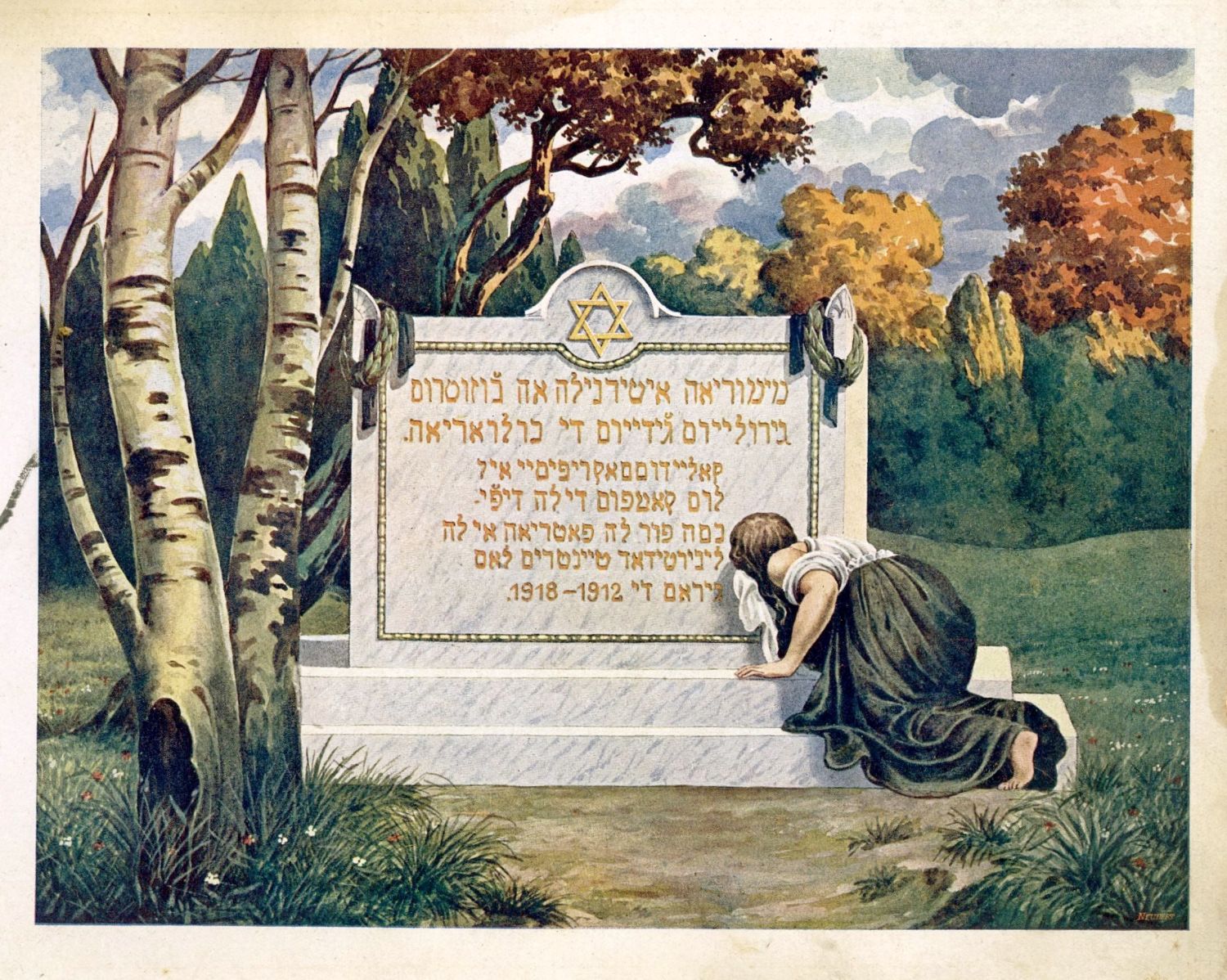
A unique memorial designed album in memory of the Jewish soldiers who fought in the Bulgarian army and fell in the First World War. Sofia, [1919], Hebrew, Ladino, and Bulgarian. Painter: P. Shlambor (ф. шламбор).
At the beginning of the album, a lamentation about 'The Jews who fell, by Lubomir Bobensky 'your memory and heroism will never be forgotten ... you liberated the Balkans ... '. Four title pages: in one a figure of Moses and David, the other in color with a figure of a woman kneeling on a Jewish monument with a memorial inscription for the Jewish fallen in Ladino language. On the third title page, a symbolic drawing of the twelve tribes, the verse: "הצבי ישראל על במותיך חלל איך נפלו גיבורים'', Star of David and the years: 1912-1918. Between these years, the Jewish soldiers featured on the album fell. On the fourth title page, a painting of the Temple Mount and the wall in a colorful lithographic print. The album includes photographs and details of no less than 400 Jewish soldiers - the names of each of them, and the short years of his life (most of them were born in the late 19th century and fall in the war in their youth). Five portraits per page.
Many of the Bulgarian Jews who enlisted in the Bulgarian army excelled in their position and reached the rank of officer. Bulgaria took an active and central part in the Balkan War alongside the Central Powers. Due to the large number of Jewish conscripts in the army, the entire public life of the Jewish community was completely silenced. During World War I, about 714 members of the Jewish community in Bulgaria fell, 28 of them officers, some of them senior. Many of the fallen were important public figures in the Jewish communities in the various Bulgarian cities.
The fate of many of the soldiers featured on the album is unknown from any other source, and the album before us is the only historical source that mentions their names, pictures, origins, and years of life.
[43] leaves, 25X18 cm. A few stains. A few peels of paint on the cover. Good condition.

10 early postcards with cartoons in favor of and against Dreyfus. Were published during the affair in the late 19th and early 20th centuries. Seven of them are undivided back.
Include antisemitic postcards, postcards mocking Emile Zola and on the other hand mocking the antisemitic Edward Drumont, postcards against Dreyfus' supporters, and others.
Overall good-very good condition.
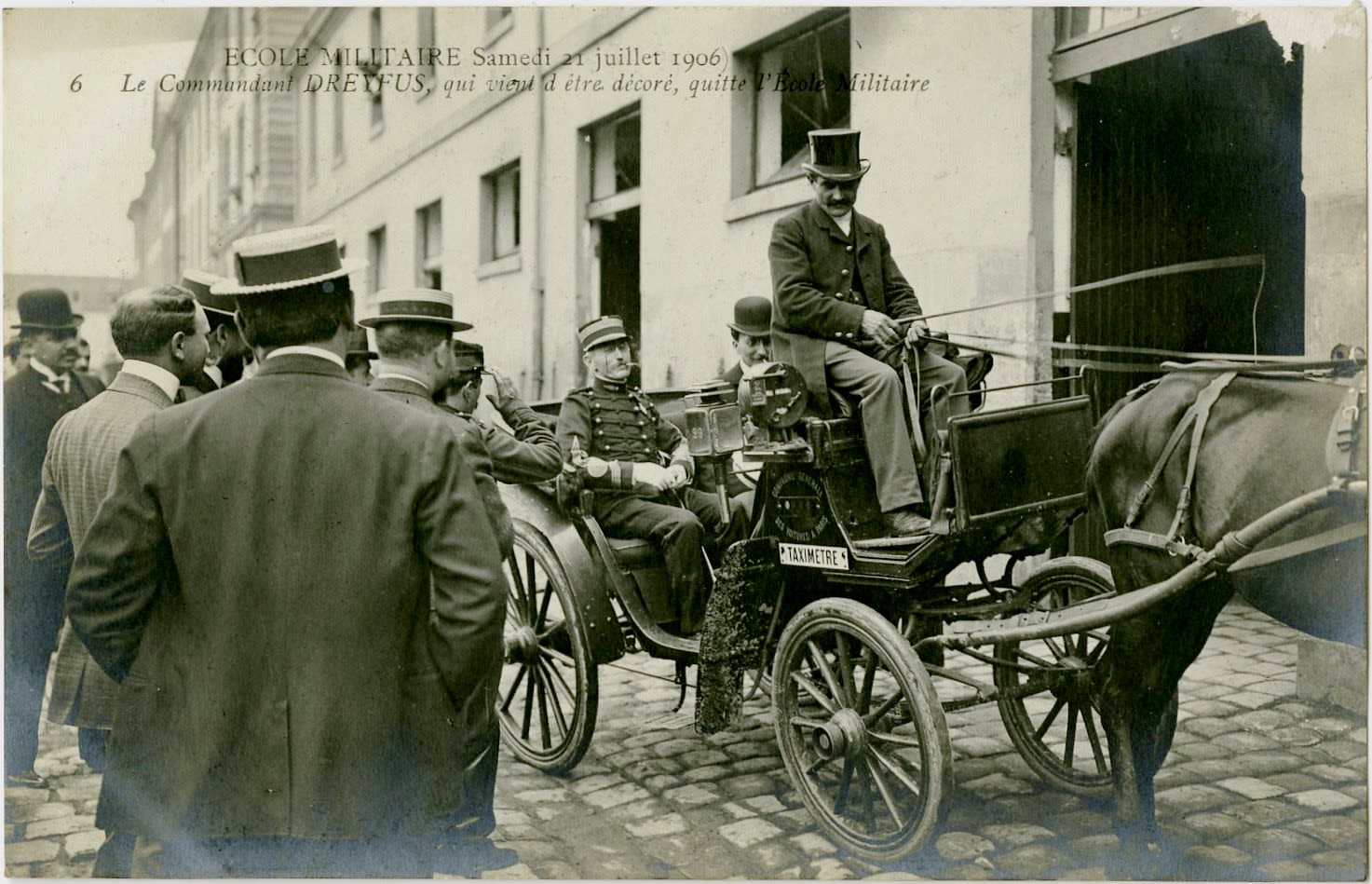
8 Real-photo (All but one) photopostcards from the honor ceremony held for Alfred Dreyfus in the courtyard of the ECOLE MILITAIRE after his total acquittal in 1906.
Among the postcards: Dreyfus is led in the chariot of honor on the way to the honor ceremony, Dreyfus talks to generals after his ranks have been restored, the Order of Honor from various angles, General Jean satisfied after awarding the Legion of Honor Cross to Dreyfus, the Order of Honor awaits Dreyfus about to leave the building, associates and generals celebrate , And more.
On July 12, 1906, the Court of Appeals overturned the verdict of the Berne Court. A day later, the National Assembly decides by majority vote to restore to Dreyfus and Picard the ranks of officers who have been deprived of them, and to raise Dreyfus to the rank of major and to award him the Legion of Honor. On July 21, the ECOLE MILITAIRE held an honorary ceremony in the presence of the military, its family, and its close friends, as the weighty response to the ceremony of humiliation that took place exactly 11 years earlier in which its ranks were removed after being accused of betrayal in the homeland.
From the requested postcards in the Dreyfus affair.
General condition very good.
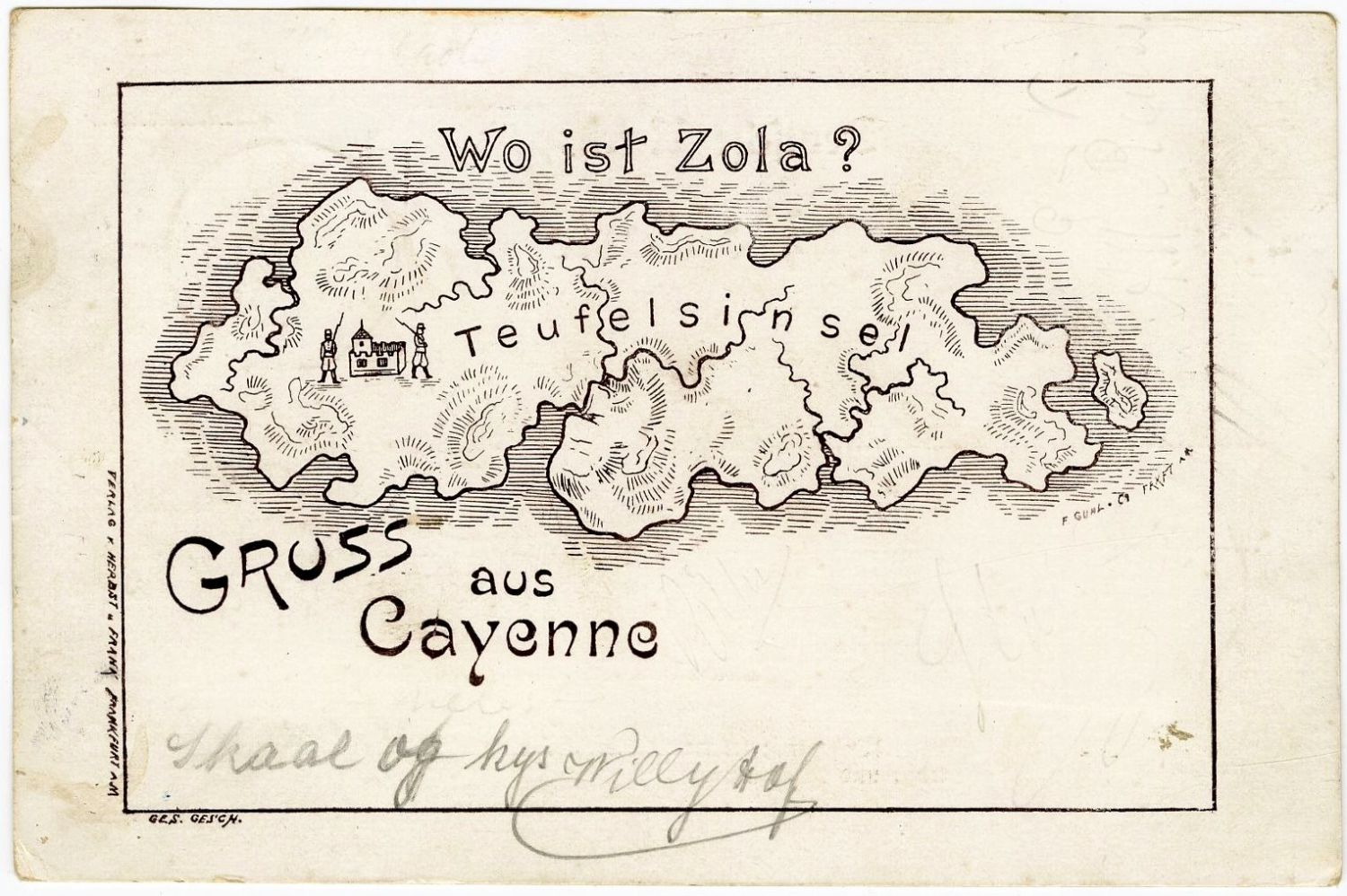
Wo Ist Zola? - 'Where's Zola?' - An early postcard issued while Emil Zola had fled France to London. Published by Herbst & Frank. Frankfurt am Main, c. 1898. The border lines in the form of a portrait of Zola.
After the French writer and publicist Emil Zola (1840-1902), of Alfred Dreyfus 'main supporters, published his article "L'aurore" ['I accuse '], proving Alfred Dreyfus' innocence, he was prosecuted for libel, sentenced to one year in prison and fled To England. Zola has been living in London for about a year under false names, and his place was unknown. The postcard before us, which was printed at that time, shows on the left the island of demons in which Dreyfus was imprisoned, and a map of European countries in which Zola may have been found. When part of the drawing of the boundary lines creates the portrait of Zola. When Zola learned of a retrial to Dreyfus he returned to Paris in June 1899.
The postcard was mailed in March 1898 (only two months after the publication of his article "L'aurore"). Very good condition.
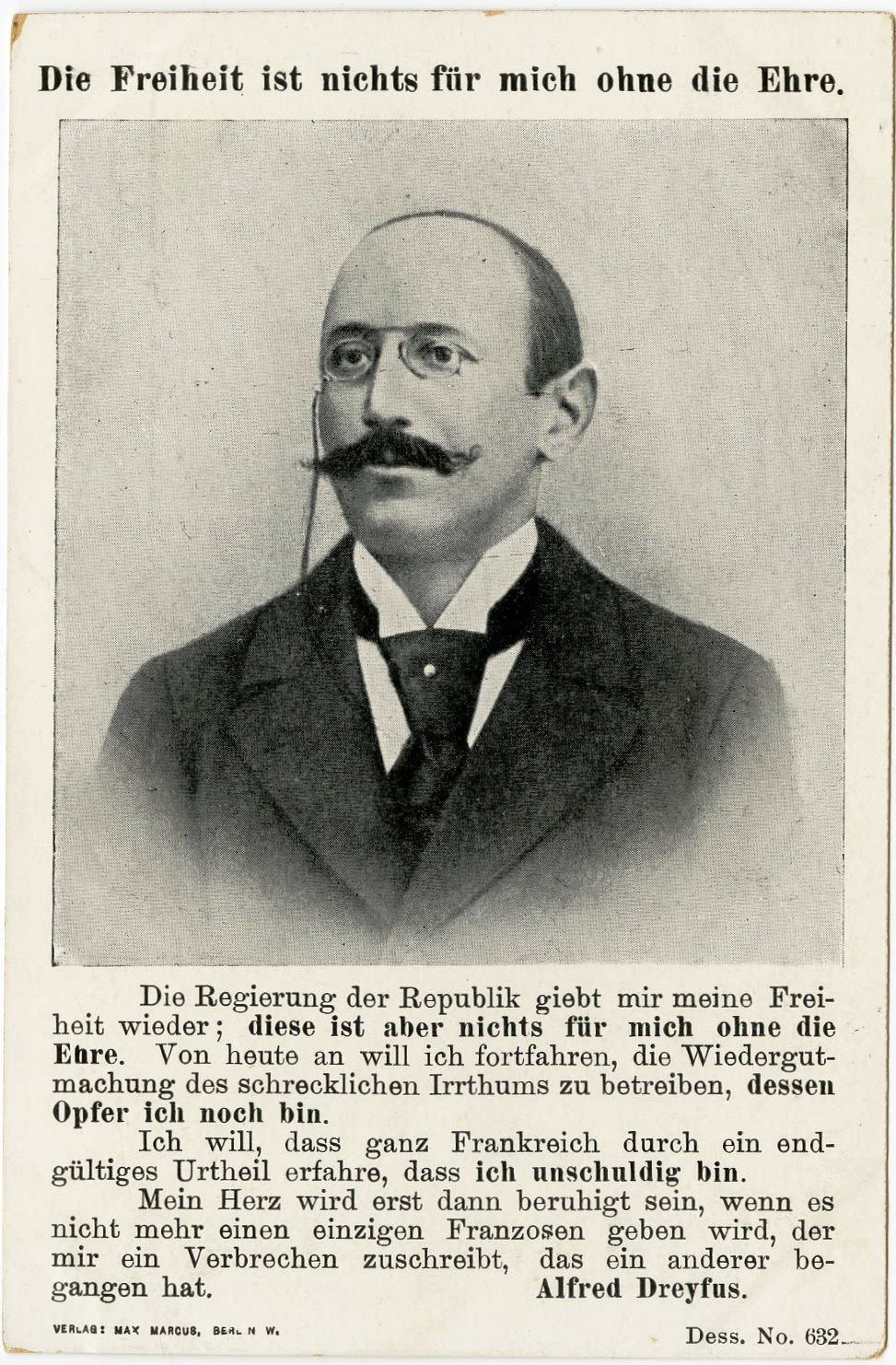
An early Real-photo postcard showing the portrait of Alfred Dreyfus under the German inscription from Dreyfus: Die Freiheit ist nichts fur mich ohne die Ehre" - '' Freedom is nothing to me without respect". Below Dreyfus portrait, and again a quote from Dreyfus himself after being informed of the shortening of his sentence which was sentenced to prison: "The Government of the Republic restores my liberty. But that is not enough ... I want all France to know in a final verdict that I am innocent. My heart will only be silent when there is not a single Frenchman left who attributes to me a crime that someone else committed."
The postcard was issued in Berlin in the late 19th century at the time of the trial, after the Court of Appeals overturned the 1894 ruling and orders to put Dreyfus on returning trial in Rennes, where Dreyfus was found guilty of treason under Mitigating circumstances, towards his final pardon. Published by Max Marcus. Extremely rare.
Undivided Back, not mailed. Very good condition.

A special issue of the Italian LA TRIBUNA ILLUSTRATA della Domenica - dated August 18, 1899 - in preparation for the absolute acquittal of Alfred Dreyfus.
The summary sheet of the Dreyfus affair. On the cover of the issue is a picture of Dreyfus in uniform in a colorful lithographic print and the name of Dreyfus in Italian pronunciation - ALFEDO DREYFUS. The publisher notes that the photo was taken from a sketch sent to Rome from Rennes. The inside pages have extensive coverage of the affair and photos of the 'heroes of the Dreyfus trial'. On the back of the issue is a large drawing from inside the court at the time of Alfred Dreyfus' acquittal.
Complete sheet. Few stains. Good condition.

Leipzig, evening, the sun sets through the window, on the top left is the sign: "A place for the night for fair guests - 8 marks." The owner of the inn holds a flashlight and asks the Jewish inn guests: 'Please sit down' when she points to a pile of straw with her finger. The inn is already full of guests at this time, the Jews are also asking for a place, but the other guests are asking them to leave. Next to the pile of straw on which a man is lying, appears the inscription: JUDEN RAUS - 'Jews out' (the famous phrase used by the Nazis against the Jews during their concentration for deportation), and the person sitting on it waves his finger 'out'. The guest sitting on the right waves a boot aimed at flying towards the unwanted Jews. The Jews, for their part, are trying to seduce the landlady with gold and diamonds in their possession, to stay. Paradoxically the Jews hold gold and diamonds but are dressed in simple and worn clothes, on the left can seen a dog pulling a bone out of the Jew's pocket. Although the assumption that Jews had more money and gold in their pockets than other peoples was exaggerated, there is a historical reason: since the Middle Ages Jews were forbidden to own land and real estate or join guilds, and were constantly subject to sudden expulsion from the cities and countries in which they lived. So they kept gold, diamonds, and other jewelry, in order to survive in other lands to which they were deported.
Published by Reinhold Knobbe, Leipzig, early 20th century. Good condition.
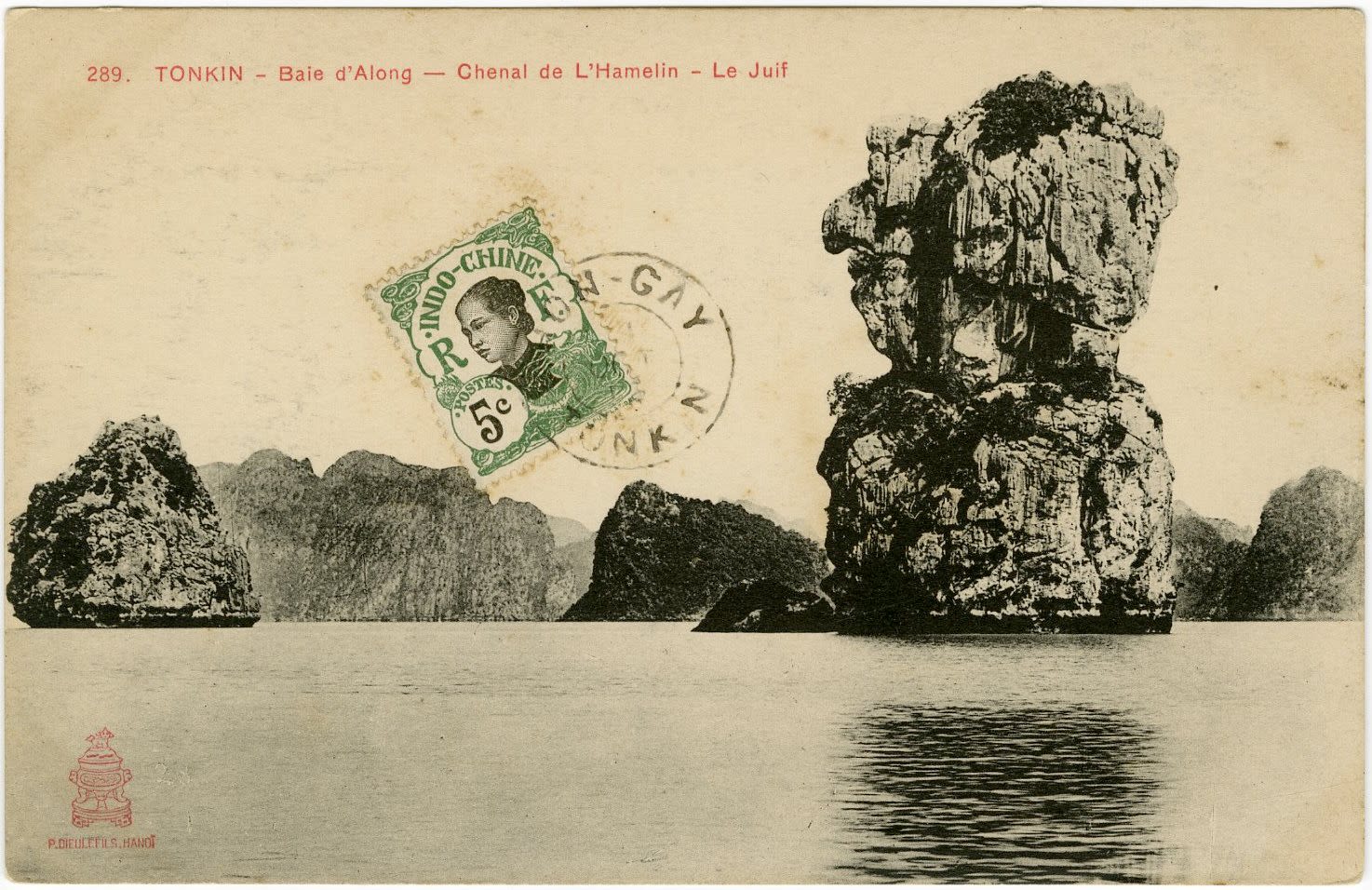
The 'Jewish' rock in Tonkin Bay, China - an anti-Semitic postcard - Early 20th century.
The jewish nose stereotype was so pervasive and ingrained throughout the world that a rock formation in a marine channel in french indochina was named "Le juif" - "The jew" due to its features that apear like a head with protruding nose When watching it from afar. The title of the postcard bears the name of the channel: 'Chanel de l'Hamelin' and the words 'Le Juif '-' the Jew'. The bay has more than 3000 islets, most of which are made out of limestone. Many are named for their shapes, such as Voi Islet (elephant) and Ga Choi Islet (fighting), and, in the postcard before us a "Jewish" nose.
Sent by mail in the early 20th century. Good condition.

An early antisemitic postcard (c. 1900) in which a Jew is seen in a stereotypical face and the accompanying antisemitic caption: "Nothing lasts forever, even the 'beautiful Jew' has become miserable and rude", and in red in large letters: 'Prosit neujahr' - 'Happy New Year'.(German)
Undivided Back. Not mailed. Good condition.

15 antisemitic postcards, various publishers and printing places, Europe and the United States - early 20th century.
In postcards: the Jew with the long nose, postcards depicting Jewish merchants as swindlers, Jews being thrown out of various places of entertainment, Jews being stereotypically painted with accompanying antisemitic captions and more.
5 Sent by mail, general condition good - very good.
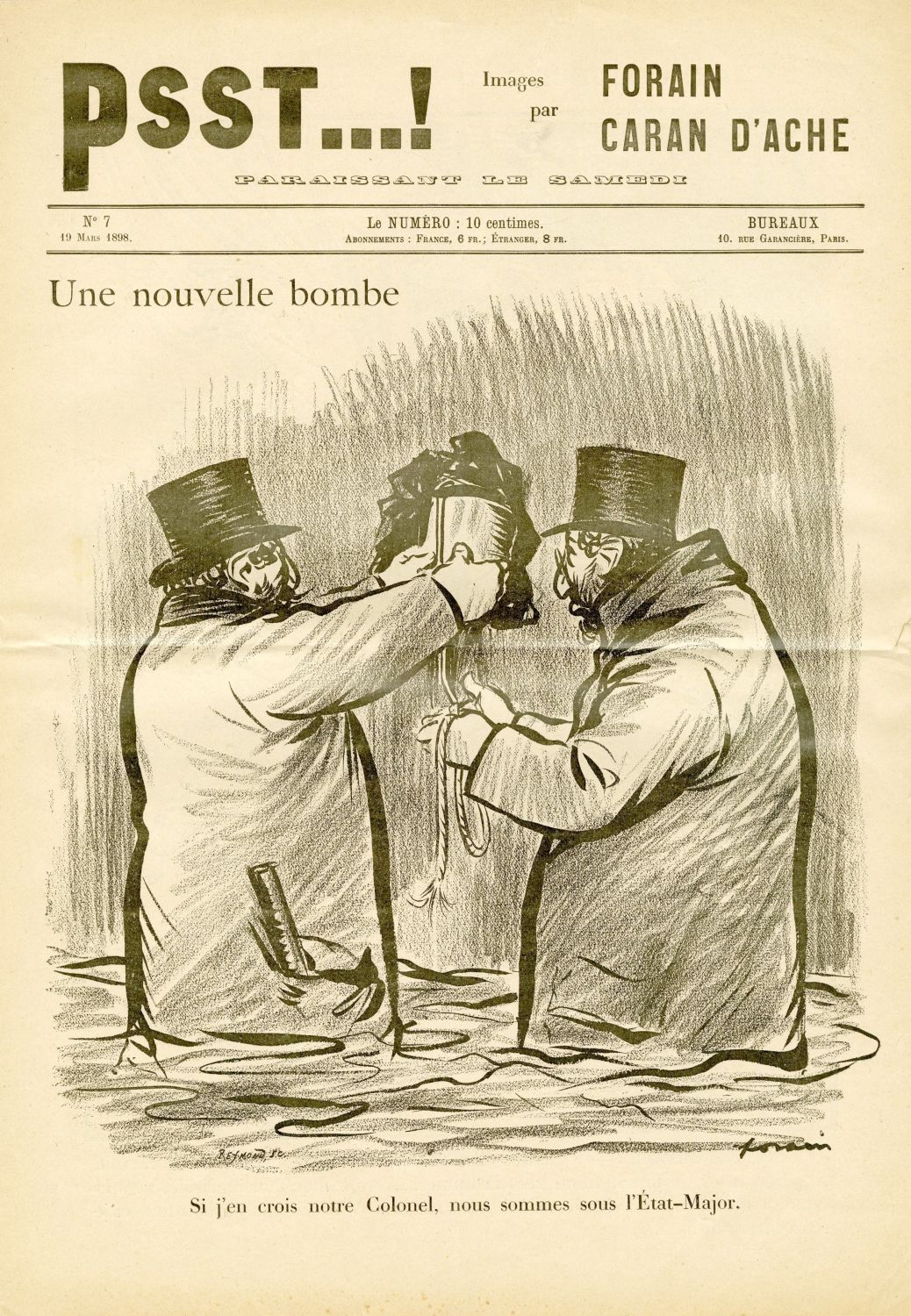
Three issues of the antisemitic and anti-Dreyfus weekly "Psst...!". Paris, 1898.
* Issue of March 19, 1898, on the cover is a large cartoon in which two Jews are seen with stereotypical faces, and a caption that hints to Dreyfus' betrayal. and the control of the Jews in the French army alleged.
* Issue dated May 28, 1898 with a large cartoon showing a Jew looking at the horizon and the antisemitic caption: 'Brother Jacob, do you see anything on the horizon? I see Joseph, he comes with the money ...'.
* Issue dated July 23, 1898 On the cover of the issue is a large cartoon mocking Emil Zola - of Dreyfus' great supporters.
Psst ...! , An illustrated magazine founded by Jean-Louis Forain and Caran d'Ach (pen name of Emmanuel Poiré). A French weekly that regularly published antisemitic cartoons during the Dreyfus trial. Released in a regular four-page format full of venomous antisemitic cartoons by, which appeared regularly during the affair.
Three sheets. Very good condition.

A LA BOTTE DU JUIF ERRANT - 'The Wandering Jew's Boots'. An advertisement card for a shoe manufacturer called LOUIS ABADIE in early 20th century France. In the front is a drawing of a youth in boots In lithographic printing. How strong the legend of the wandering Jew was in the minds of French citizens can be learned from the fact that on the back of the card the manufacturer lists the excellent quality of the shoes and boots it produces, under the name 'Wandering Jewish Boots'. In order to market his goods as quality, the advertiser uses the expression of the boots of the 'wandering Jew' as such that for years they never wear out. Extremely rare.
Size: 14x9 cm. Very good condition.
Created and Develop with 🤍By webe ©2024